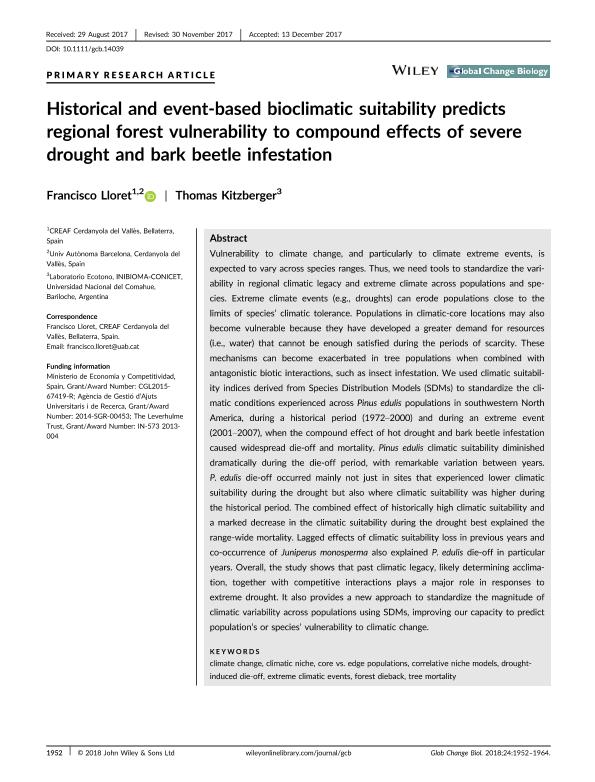Mostrar el registro sencillo del ítem
dc.contributor.author
Lloret Sarmiento, Francisco Jose

dc.contributor.author
Kitzberger, Thomas

dc.date.available
2020-02-12T17:54:57Z
dc.date.issued
2018-05
dc.identifier.citation
Lloret Sarmiento, Francisco Jose; Kitzberger, Thomas; Historical and event-based bioclimatic suitability predicts regional forest vulnerability to compound effects of severe drought and bark beetle infestation; Wiley Blackwell Publishing, Inc; Global Change Biology; 24; 5; 5-2018; 1952-1964
dc.identifier.issn
1354-1013
dc.identifier.uri
http://hdl.handle.net/11336/97281
dc.description.abstract
Vulnerability to climate change, and particularly to climate extreme events, is expected to vary across species ranges. Thus, we need tools to standardize the variability in regional climatic legacy and extreme climate across populations and species. Extreme climate events (e.g., droughts) can erode populations close to the limits of species' climatic tolerance. Populations in climatic-core locations may also become vulnerable because they have developed a greater demand for resources (i.e., water) that cannot be enough satisfied during the periods of scarcity. These mechanisms can become exacerbated in tree populations when combined with antagonistic biotic interactions, such as insect infestation. We used climatic suitability indices derived from Species Distribution Models (SDMs) to standardize the climatic conditions experienced across Pinus edulis populations in southwestern North America, during a historical period (1972–2000) and during an extreme event (2001–2007), when the compound effect of hot drought and bark beetle infestation caused widespread die-off and mortality. Pinus edulis climatic suitability diminished dramatically during the die-off period, with remarkable variation between years. P. edulis die-off occurred mainly not just in sites that experienced lower climatic suitability during the drought but also where climatic suitability was higher during the historical period. The combined effect of historically high climatic suitability and a marked decrease in the climatic suitability during the drought best explained the range-wide mortality. Lagged effects of climatic suitability loss in previous years and co-occurrence of Juniperus monosperma also explained P. edulis die-off in particular years. Overall, the study shows that past climatic legacy, likely determining acclimation, together with competitive interactions plays a major role in responses to extreme drought. It also provides a new approach to standardize the magnitude of climatic variability across populations using SDMs, improving our capacity to predict population's or species' vulnerability to climatic change.
dc.format
application/pdf
dc.language.iso
eng
dc.publisher
Wiley Blackwell Publishing, Inc

dc.rights
info:eu-repo/semantics/openAccess
dc.rights.uri
https://creativecommons.org/licenses/by-nc-sa/2.5/ar/
dc.subject
CLIMATE CHANGE
dc.subject
CLIMATIC NICHE
dc.subject
CORE VS. EDGE POPULATIONS
dc.subject
CORRELATIVE NICHE MODELS
dc.subject
DROUGHT-INDUCED DIE-OFF
dc.subject
EXTREME CLIMATIC EVENTS
dc.subject
FOREST DIEBACK
dc.subject
TREE MORTALITY
dc.subject.classification
Ecología

dc.subject.classification
Ciencias Biológicas

dc.subject.classification
CIENCIAS NATURALES Y EXACTAS

dc.title
Historical and event-based bioclimatic suitability predicts regional forest vulnerability to compound effects of severe drought and bark beetle infestation
dc.type
info:eu-repo/semantics/article
dc.type
info:ar-repo/semantics/artículo
dc.type
info:eu-repo/semantics/publishedVersion
dc.date.updated
2019-10-10T13:54:59Z
dc.journal.volume
24
dc.journal.number
5
dc.journal.pagination
1952-1964
dc.journal.pais
Reino Unido

dc.journal.ciudad
Londres
dc.description.fil
Fil: Lloret Sarmiento, Francisco Jose. Universitat Autònoma de Barcelona; España. Consejo Superior de Investigaciones Científicas. Centre de Recerca Ecológica I Aplicacions Forestals; España
dc.description.fil
Fil: Kitzberger, Thomas. Consejo Nacional de Investigaciones Científicas y Técnicas. Centro Científico Tecnológico Conicet - Patagonia Norte. Instituto de Investigaciones en Biodiversidad y Medioambiente. Universidad Nacional del Comahue. Centro Regional Universidad Bariloche. Instituto de Investigaciones en Biodiversidad y Medioambiente; Argentina
dc.journal.title
Global Change Biology

dc.relation.alternativeid
info:eu-repo/semantics/altIdentifier/doi/http://dx.doi.org/10.1111/gcb.14039
dc.relation.alternativeid
info:eu-repo/semantics/altIdentifier/url/https://onlinelibrary.wiley.com/doi/abs/10.1111/gcb.14039
Archivos asociados
